Think Twice Before Ordering These Overpriced Menu Items At A Restaurant

Hispanolistic/Getty Images
Going out to eat at a restaurant is a luxury and an indulgence. Instead of working away in the kitchen to prepare a home-cooked meal, you can sit back and enjoy a delicious dish — no cooking, cleanup, or planning required. And while the convenience and enjoyment of eating out is usually worth the money to many, most people also don't want to be throwing away their hard-earned cash unnecessarily. So next time you snag a reservation at your favorite restaurant or head to the nearest neighborhood spot for a meal, it might be wise to assess the menu a little more critically before ordering.
It's no secret that restaurants mark up their menu items; like any business, creating a profit margin on their goods is how they stay in business. But when it comes to pricing, not all dishes are created equal. Certain items on a restaurant menu are notoriously overpriced — and it might not be the things you expect. Learn more about which items on a restaurant menu are usually overpriced, and you may think twice before ordering them the next time you're out at your favorite dining establishment.
Soda

Gado/Getty Images
While it can be tempting to order a crisp, carbonated soda with your meal when you're eating out (especially if there are unlimited refills), it's usually one of the most overpriced items on a restaurant menu. These beloved beverages are a huge moneymaker for restaurants, with the soda and ice costing only a fraction of what a restaurant charges.
To make fountain soda, a restaurant simply needs the soda syrup, water, and carbon dioxide gas for carbonation. Restaurants that sell a large volume, or restaurant chains, likely buy their syrup and CO2 gas in bulk, affording the business a break on the price and helping keep their costs lower. Though you also need to factor in the restaurant's expenses like disposable cups, lids, straws, labor, and other overhead. But, some restaurants make so much on fountain drinks that they are able to take a loss on certain food items.
Pasta

Alexander Spatari/Getty Images
As of April 2025, the average cost of a pound of dried spaghetti is only $1.36 according to the U.S. Bureau of Labor and Statistics. When you account for the fact that a pound of pasta is multiple servings, it quickly becomes clear that the cost of ingredients to make restaurant pasta dishes is relatively low compared to what they charge customers. Though some restaurants do make homemade pasta, the necessary ingredients — eggs, flour, and water — are still generally affordable restaurant staples, especially compared to other more expensive items like protein.
Though pasta dishes typically require additional ingredients like oil, cheese, spices, and any other mix-ins like vegetables or meats that add to the restaurant's costs, these popular menu items still offer dining spots a way to make up other costs (especially when you consider the fact that pasta dishes are ideal for using up vegetables that may be near the end of their shelf life). Though some pasta dishes are time-intensive and require a lot of chopping or constant attention like risotto, the overall cost of ingredients is often very low compared to the final price customers see on the menu.
Eggs

Anna Cinaroglu/Getty Images
Breakfast is a great opportunity for restaurants to make money; fan-favorite breakfast ingredients cost an average of 25-30% of the menu price, compared to 30-35% for dinner items. And one of the most beloved breakfast must-haves? Eggs. Even though the cost of eggs has steadily increased throughout 2025 due to avian influenza, eggs are still offering a major moneymaking opportunity for many restaurants.
Unlike other dishes, eggs are particularly lucrative for restaurants because they are often served solo (or with other low-cost breakfast staples like hash browns or pancakes). Fried, scrambled, or poached eggs don't require many extra ingredients and only need oil or butter (depending who you ask), salt, and a few other kitchen staples to prepare. They're also fast to cook, requiring little time from a chef or line cook compared to more complex dishes. Though omelets require more ingredients and a little added attention, they also typically fetch a higher price tag than plain eggs to compensate for the cost of the extra ingredients and additional time required.
Bottled water

Simpleimages/Getty Images
Restaurants typically pay wholesale costs for all of their items — including bottled water — because they are buying at such high volumes. As of 2023, the average wholesale price per gallon of domestic non-sparkling bottled water was $1.44. When you consider that people, on average, drink roughly one glass or roughly 8 ounces of water with a meal, it means that a single gallon could serve about 16 diners. Especially when you consider that there is little labor or preparation involved in serving bottled water, it becomes clear that this beverage could generate a lot of revenue for a restaurant.
Sparkling water is even more expensive than flat bottled water. Because it requires more time and effort to carbonate the water, it is a more expensive product in general, and restaurants usually pass this increased expense on to the customer. Even at bars, club soda or sparkling water from the soda gun often incurs a fee of a few dollars despite the fact that the fizzy beverage costs the restaurant very little to serve.
Tap water, on the other hand, actually costs a restaurant money when you factor in the glassware and labor to serve, refill, and wash the dishes — not to mention the cost of the water bill. If you're looking to lower your bill when eating out, opt for this typically free alternative to bottled water.
Entree salads
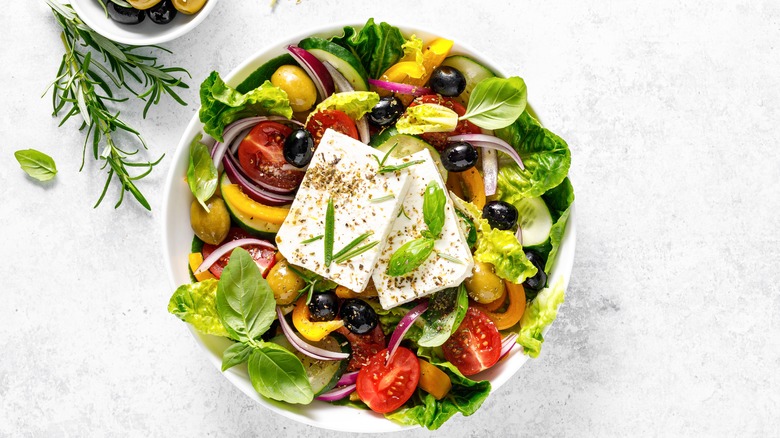
Sea Wave/Shutterstock
Salads can be a huge revenue generator for restaurants thanks to their often-affordable ingredients. Caesar salads, for example, often have only a few ingredients like lettuce, cheese, croutons, and dressing. Restaurants are usually buying these ingredients in large quantities at wholesale prices (especially for crowd-favorite salads), which helps to keep their ingredient prices low. While the chopping, shredding, and mixing required to make a salad are more labor-intensive than, say, grilling a steak, the food cost is low enough (and the menu prices are usually high enough) to make up for it.
Some salads, however, may contain high-cost ingredients such as organic produce, heirloom tomatoes, organic chicken, or specialty ingredients like prosciutto that can drastically increase the restaurant's ingredient costs. As a result, these menu items may be priced at a higher premium than their more average counterparts to make up for it; high-end eateries in major cities like New York or Washington, D.C. have been known to charge upwards of $50 for a salad topped with a premium protein like steak or lobster.
Wine
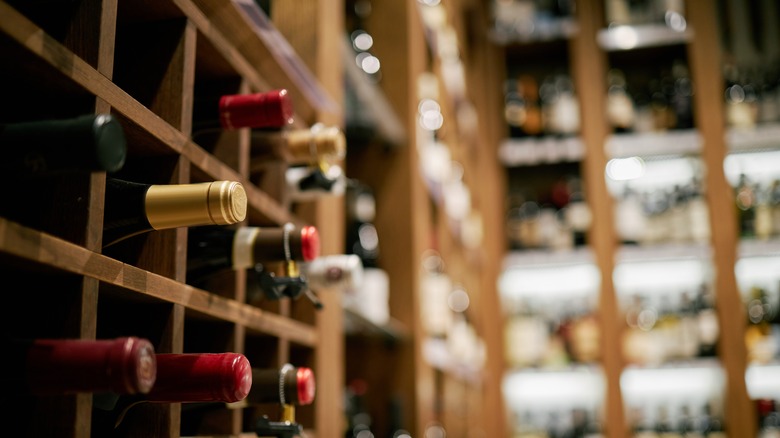
SeventyFour/Shutterstock
Wine is not only a significant investment for diners, but for the restaurant, too — and that's reflected in the pricing. Because restaurants tend to purchase wine in smaller quantities than bulk items like produce or other drinks like coffee or soda, it's reflected in the menu price. The restaurants also need to factor in their investments in both time and storage space, adding to the overall markup.
If you do opt to purchase wine when dining out, try to go for a full bottle instead of just a glass. Restaurants factor in spoilage when pricing their wines by the glass (if only two of five glasses are drunk, the rest goes to waste), so the per-glass price is always more than the full bottle by volume. But be cautious when choosing your bottle — the more affordable wines tend to have the highest markups. Though it would be a bigger overall investment, your best bet might be springing for a luxury wine label to get the most bang for your buck. Just familiarize yourself with the different types of white wine and every type of red wine first, so you're sure to pick a bottle you'll like.
Truffles
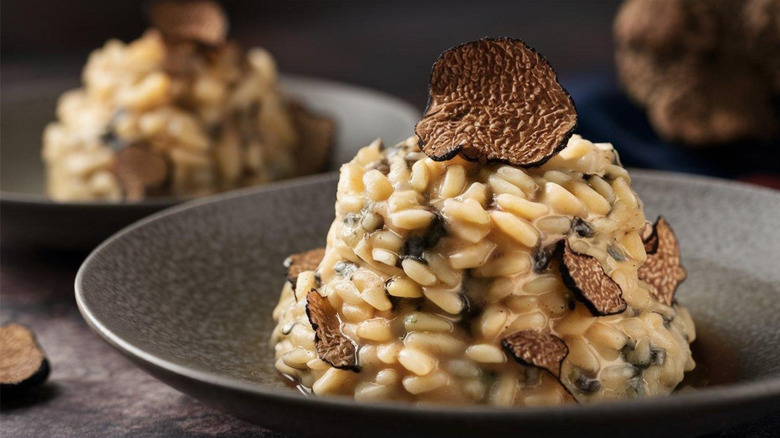
Food magic/Shutterstock
There's no denying that fresh truffles are expensive; fine white truffles cost roughly $4,000 per pound while the finest black truffles cost between $300 to $800 per pound. The reason for these astronomical prices is the rarity of the truffles. These fungi need very specific conditions to grow in the first place, and even then, they only grow for a few months of the year. They grow slowly and require specially trained dogs or pigs to find them in the forest so they can be harvested. So when you see truffles listed on a restaurant menu, it makes sense that the price tag is quite high, right?
Though it would seem so, what many restaurants don't advertise is that their truffle menu items often actually get their flavor from truffle oil, not fresh truffles themselves.And truffle oil actually contains very little actual truffle; oftentimes it's not even real truffle at all, but a synthetic truffle flavor. So if your meal is topped with real shaved truffle, an exorbitant price tag might make sense. But for truffle fries topped with a little bit of flavored oil? Probably not.
Coffee

Thinnapob Proongsak/Shutterstock
Drinks in general seem to be a major moneymaker for restaurants, thanks to their low cost and easy prep — and coffee is no different. A cup of coffee might cost a restaurant, cafe, or coffee shop 15 or 20 cents to make; but you're probably paying several dollars (if not more at high-end coffee shops in major cities like New York).
Though the cost of espresso is slightly higher than that of coffee, Americanos and other espresso drinks typically also come with a higher price tag; as of early 2024, the average national price for a latte was hovering around $5.50. Though the addition of milk and sugar to many of these coffee and espresso drinks adds to a restaurant's total ingredient costs (not to mention labor and overhead), there is still a substantial markup passed on to the end consumer.
And customers might continue to see these prices rise — but not because the restaurants are getting greedy. Due to supply chain issues and other increasing costs, the cost of coffee — from cold brew to mochas — is slowly rising, and many restaurants will likely need to bump up their prices to keep up.
Oysters
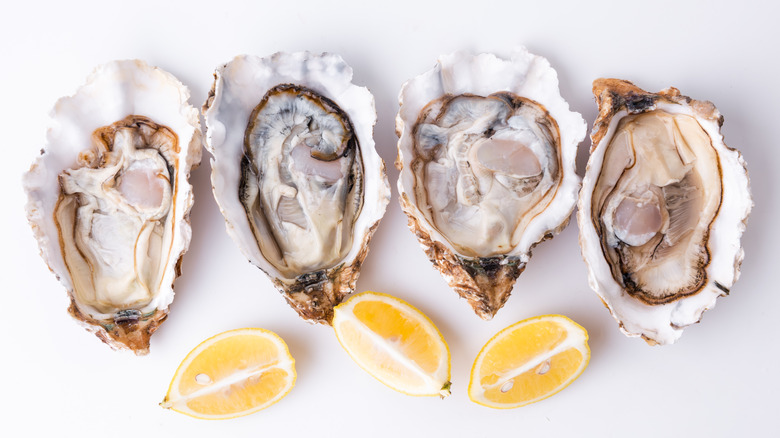
Huizeng Hu/Getty Images
Oysters are beloved for their briny, refreshing, umami flavor. And the price of elaborate dishes like oysters Rockefeller tends to reflect the ingredients and labor required to concoct the dish. The price of shucked oysters, on the other hand, is more of a revenue-driver for restaurants (with the exception of rock-bottom oyster happy hour prices, which are often a loss-leader for restaurants meant to drive big-ticket purchases on alcohol and appetizers).
It's not uncommon to see the price per oyster listed on a restaurant menu between $3 and $6 each, though the price varies depending on market and harvesting conditions and whether the oysters are East or West Coast. East Coast oysters are smaller and brinier while West Coast oysters are larger and creamier. No matter which type is being served, there's usually very little preparation required for fresh oysters; the restaurant needs to shuck and plate the oysters and create any accompaniments like a mignonette or cocktail sauce. Given the simplicity of preparing this delicious shellfish, a high price tag doesn't typically correlate to extra labor.
Pizza
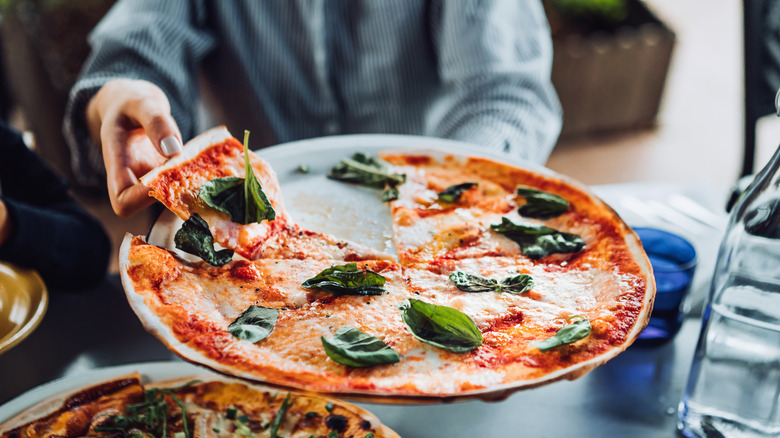
D3sign/Getty Images
Pizza is one of the most popular foods in the U.S., with about 350 slices eaten every second. And like pasta, pizza is a low-cost, high-return addition to restaurant menus. The dough requires a few basic ingredients (just flour, yeast, salt, and water), and the sauce uses affordable pantry ingredients like crushed tomatoes. While the toppings like cheese are more expensive and can increase a restaurant's ingredient costs quickly (especially premium toppings like prosciutto or sausage), specialty pizzas tend to fetch a higher price, too. Pizza add-ons and some of the best pizza toppings also help restaurants drive revenue by increasing the cost of the pie for the customer without adding a lot of ingredient costs.
The overpriced nature of pizza is even more extreme when sold by the slice. Though the cost of a slice of pizza varies considerably depending on where you're located (with less than $5 in New York City for a slice of pepperoni to over $9 in Alaska), there's usually an up charge when buying a single piece compared to a whole pie — but it's sometimes worth it for the added convenience if you're on the go.
Burgers
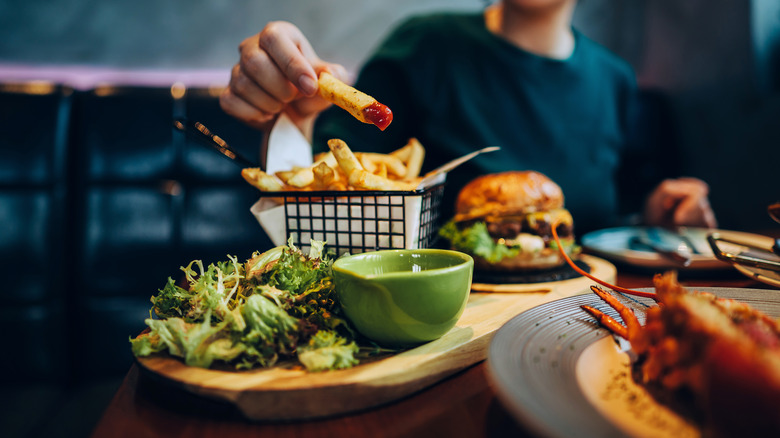
D3sign/Getty Images
Though they may not seem like it, burgers can be a big revenue generator for restaurants. The ground beef is the most expensive ingredient, but is relatively low-cost compared to other beef items like steak (because ground beef is typically made from less-desirable cuts of the cow). The burger's other ingredients — the bun, condiments, and veggies like tomato, onion, and lettuce — are all very affordable at restaurant wholesale pricing. Many restaurants also offer premium toppings and condiment add-ons (like bacon, fried eggs, or avocado) that can quickly drive the cost up even further for the customer.
If you're craving a burger, you may also be craving fries. While many restaurants include them (or other tasty fried foods) as a side, some establishments require them to be purchased separately. This costs the customer more than the burger alone and often adds to the restaurant's revenue. Tack on a soda, beer, or other beverage, and this order could be a real moneymaker for any restaurant.
Vegetarian dishes
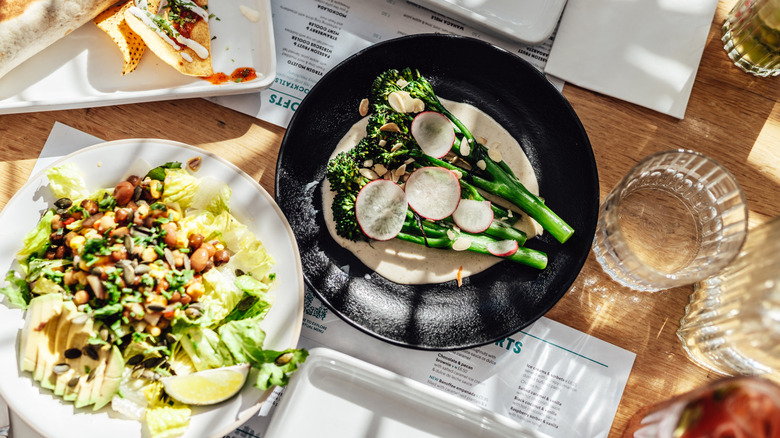
Oscar Wong/Getty Images
Protein costs often eat up the majority of a restaurant's ingredient budget. And while it's expensive for the restaurant to purchase, meat like chicken, steak, and pork usually has a small profit margin to keep pricing as affordable as possible for customers. Some high-end proteins, like certain steak cuts, are even priced at a break-even point and, in certain cases, positioned as loss-leaders.
Vegetarian dishes, on the other hand, are usually a big revenue generator for restaurants. Many of these dishes have a hearty vegetable, like potatoes, a grain, or tofu as one of their main ingredients to create a filling, satisfying meal. Most of these vegetarian and vegan-friendly ingredients are also very affordable — especially when compared to meat and fish. Even when accompanied by fresh herbs and spices, seasonal produce, or legumes like beans, these vegetable-forward dishes almost always cost less than their center-plate protein counterparts.
And the best part for restaurants? Adding these types of dishes to the menu not only helps drive revenue among existing customers, but can also help expand a restaurant's customer base. Creative and delicious vegetarian or vegan meals appeal to a wider audience and, in turn, can help increase overall revenue, too.
French fries and onion rings
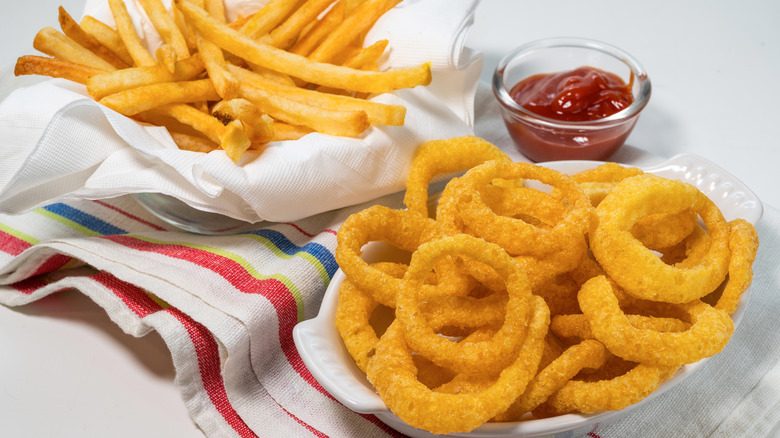
Tetra Images/Getty Images
There aren't many ingredients more humble than potatoes and onions. These affordable root veggies are only a small line-item in a restaurant's overall budget; the cost of wholesale potatoes is between 37 cents and $1.38 per pound, while the cost for wholesale onions is between 10 and 91 cents per pound. These affordable ingredients are the foundation of beloved side dishes like french fries and onion rings. In addition to keeping ingredient costs low, french fries and onion rings (along with most fried foods) also don't require a lot of time or labor to prepare. These fast and delicious side dishes help keep overall costs even lower, resulting in more money in the restaurant's pockets.
Though there are minimal costs for oil, salt, and a bit of labor, a side of french fries is still usually sold at very high margins — even some of the best fast food french fries. Though onion rings require a few more ingredients to make the breading, it's safe to assume the results would be similar.



